
Today I have the pleasure of introducing guest poster Sandy Coghlan, an Aussie Boomer who has written a diary-style book, Yesterday: A Baby Boomer’s Rite of Passage, about her sojourn in Europe in the magical mystery tour days of the late 1960s and early 1970s.
Back then, it was literally cheaper to travel on the Continent than it was to stay home — especially if you were willing to catch a few winks on some overnight ferries, crash with friends or in inexpensive hostels, and maybe do some hitchhiking that didn’t always take you where you planned to go. (And many young travelers did just that.)
I enjoyed Sandy’s account in part because — despite our differences in nationality, gender, and travel experience — it reminded me of my own first adventures in Europe nearly 50 (gasp!) years ago: memorable moments of discovery and revelation, and perhaps even more memorable moments of wrong turns and outright screw-ups, which, as most travelers know, actually become some of the best stories over the decades.
For those of you lucky enough to have roamed around Europe during that era, I hope it jogs some memories of your own. But I also hope all readers will appreciate it as a portrait of another, very distinctive time for burgeoning world travelers.
Lessons From Her Book
Here are Part I of excerpts from Sandy’s recently published book, which was culled from her diary and letters written at the time. (Part II will follow.) While her travels span the period from late 1969 to 1973, the book centers around her experiences in late 1969 and 1970. I’ll provide some context between the entries as needed.
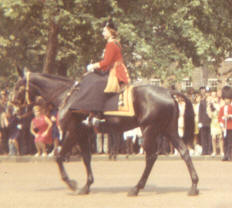
A much younger Queen Elizabeth trooping through London.
As Sandy puts it, Yesterday is “basically about learning to be brave and doing what you always wanted to do but doubted you had the courage to, then recognizing you could do anything if you set your mind to it.”
Sandy’s photos and postcards gathered from her travels add a nice vintage touch. But while there’s a lot of nostalgia attached to this, there’s also plenty to chew over for present-day travelers as well: namely, never be afraid to go where you’ve always wanted to go, by summoning the courage and then taking the plunge.
Sandy began her journey with a long boat trip on Chandris Lines from Australia as part of a mass exodus of young Aussie travelers who set out to roam the globe in the age of the Beatles’ “Long and Winding Road,” psychedelic VW vans, and a sense of wonder at what the world beyond their shores had to offer. I remember them well from my own travels, admiring their adventuresness as they wandered Europe and beyond, often for several years, to experience the ultimate “gap years.”
Sandy begins with an informative introduction, which includes some fascinating background on the era’s young Aussie baby boomer exodus:
By Sandy Coghlan

I was there.
It is estimated that in the late 60’s and early 70’s, around two million Australian baby boomers boarded a ship or jumped on an aeroplane and headed off to Europe.
At least one person out of every seven who lived in this country at that time found innovative ways to bare their upper arm and proudly reveal their status symbol vaccination scar.
If you were born after 1980, you might think that’s not such a big deal. Today, more than half our population of 25 million owns a passport, and jetting off to distant shores is what most people do when they need a break.
Believe me, in the 1960’s, it WAS a big deal.
If Peter Allen had written “I Still Call Australia Home” three decades earlier, it would have been “I Still Call England Home.”
Our parents and grandparents and those before them were proud British subjects who called England home, even though few had ever been there and most never would.
Heck, most Australians had never even been outside their own state!
Those who could afford to visit ‘home’ needed to be intrepid travellers indeed. The first Qantas flight from Australia to the UK in 1935 took 12 days and included 43 stopovers.
Shortly after the end of World War 2, modern aircraft cut the journey to a mere four days with just six stopovers, only two of those requiring overnight stays.
This hippity-hop to England became known appropriately as the Kangaroo Route.

Propeller-driven and noisy, these state-of-the-art (for their time) aeroplanes had non-pressurized cabins which prevented them flying high enough to avoid inclement weather. Delays were frequent, turbulence common, and air sickness bags absolutely essential.
Of course, if you really wanted to ‘visit home’, there was always sea travel, but ships in the late 40’s and the 50’s had little in common with modern day passenger liners. Most were troop ships hastily converted to carry the first wave of migrants to Australia from war-torn Europe.
The trip between continents was long and arduous. Passenger comforts were not a priority. Food was plain and often inadequate. Triple-tiered bunks were built into every available space — including the hold — and bathrooms were communal. There was certainly no entertainment to keep passengers amused.
Faced with the choice of clinging to a paper bag for 4 days or turning green for 6 weeks, most opted for the less painful Kangaroo Route.
Everything Changed for Aussie Travelers
Then, everything changed. To understand why, we need to go back to the end of World War II.
At that time, Australia’s population was a mere seven million, which was a pitifully small number for such a large and isolated country. Not only did this create a critical labour shortage for emerging industries, but the threat of Japanese invasion during the war had revealed our vulnerability. We desperately needed more manpower to defend ourselves in the event of another war.

The Aussie government formulated a plan. Invite migrants from war-torn Europe and the UK to settle here, give them a choice between air or ship travel and provide them with temporary (albeit basic) accommodation on arrival As long as they stayed for a minimum of two years, it would only cost them ten pounds, or the European equivalent of that amount.
Between 1945 and 1982, over four million people took advantage of this opportunity to start a new life.
Flushed with this scheme’s initial success, our first immigration minister, Arthur Calwell, reminded Australians that we must “populate or perish.” Families were encouraged to produce more children and Aussies performed their patriotic duty more enthusiastically than any other country, resulting in a baby boom of massive proportions. The arrival of these ‘baby boomers’ over the next two decades (1945 to 1965) increased the population by around five million.
By the early to mid 1960’s, Australia’s economy was booming. For the first time, people had money to spend.
Shipping lines began to realize that filling their ships with paying passengers for the return journey to Europe would make the migrant trade even more profitable, so they began improving on-board facilities, turning dormitories into comfortable cabins with private facilities, adding air conditioning, cinemas, swimming pools and more attractive menus.
They also offered competitive return fares, and the airlines quickly followed their example.
The shipping lines were also astute enough to recognize that their most lucrative market would be found within the 18 to 25 age group.
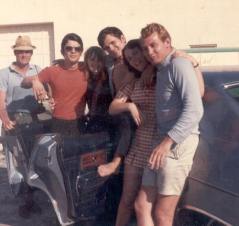
How right they were! The first wave of Aussie boomers were now wage-earning adults with money burning holes in their pockets.
These were the generation born to parents who had struggled through the great depression and at least one world war, if not two. They had not dared to step out of line, but it was a line their children chose to reject.
It is estimated that between 1965 and 1977, around 40 percent of baby boomers born or raised in Australia set off to see the world. They absorbed whatever Europe had to offer, then returned to share that knowledge with all who cared to listen.
As a result, Australia was dragged — kicking and screaming — from an isolated colony of Mother England into a vibrant and thriving cosmopolitan nation.
The baby boomer exodus flared for one brief and shining decade, then flickered out. It had served its purpose. Flights to Europe had become faster, more comfortable and less expensive. Future generations would think nothing of travelling to Rome, London or Paris for a three week vacation.

By 1977, it was mostly all over.
There will never be another time like it.
Sandy’s European Tour Begins
We pick up her narrative after Sandy has completed a long boat trip from Australia to Southampton, England, the main entrance port for London. It’s her first taste of Europe, always an intoxicating moment, though you also get a sense of her initial shock, shall we say, at encountering the big city.
As she puts it, “I left Australia by ship, alone and terrified, two weeks after my 21st birthday,” with plans to travel to Rotterdam after London to meet a handsome Dutch penpal. (More on that later.)
During her travels, Sandy paired up at times with different friends, old and new. The first is Sue, an ex-colleague in Melbourne who was already living in London when Sandy arrived en route to Rotterdam.
FIRST TIME IN LONDON (November 18, 1969)
Sue came to meet me at Southampton and we boarded the train at 8:30pm, arriving at Victoria station in London at 10pm. I thought I was finally in London. And I was!
But from the platform at Victoria station we had to go down an escalator and take another train to Charing Cross station, and then we changed to another train for Chelsea station, and after an hour of travelling from Victoria Station to Chelsea, we were STILL in the centre of London and I hadn’t even poked my head above ground yet!
Can you imagine that? Nearly nine million people — almost the entire population of Australia — all crammed into just one city.
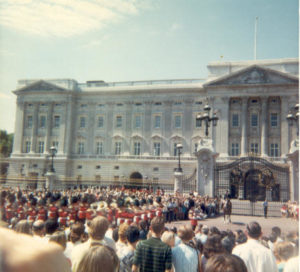
Trooping the Colours, Buckingham Palace, 1970
I quickly learnt the first lesson in using the underground in London: you must, must, MUST stay on the left side of the escalator, because the moment you put your heavy bag down beside you, even at 11pm, people will be alerted in their homes and restaurants and shops and they will come from all over London for the sole purpose of running up the right side and kicking your bag or falling over it and yelling at you for putting it there!
Carnaby Street Beckons
This morning we left at about 8am and went into town, wherever that is … I mean, in London it’s everywhere! I found it so amazing that you can walk along a quiet little tree-lined street on a cold foggy morning (which we did) and there’s total silence, but then you turn a corner (which we did) and you’re in a bustling, noisy city.
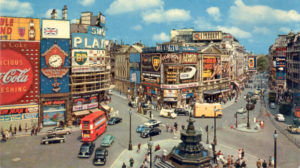
Piccadilly Circus, 1969
Sue asked me what I wanted to see before I had to return to the ship because we didn’t have much time, and straight away I said Carnaby Street. She wasn’t even sure how to get to it because she hadn’t been there yet, so she looked it up in her A-Z street directory and we took a train to Piccadilly Circus and wow was that ever huge and busy.
There were streets going off in every direction and great big neon signs all over the place and red double-decker buses and theatres and people and even more people!
We had to walk for about ten minutes down one of the streets that ran off Piccadilly Circus, but we eventually found Carnaby Street. What a surprise! I was expecting this great big, wide, long street full of all these fashionable dress shops, but it’s actually not much bigger than a laneway and there were crowds of people everywhere. There are lots of little shops all with the latest mod fashions and we wandered up and down checking them out. We had such a good time we almost forgot to keep track of the time.
When Sue looked at her watch, it read 12:20pm. I had to be back on board the ship by 3pm, which meant catching the 12.45 boat train from Victoria or I’d be walking to Rotterdam! It was a mad dash but we made it with minutes to spare.
I hardly had a chance to give Sue a quick hug and thank her before jumping on the train and waving goodbye to her as we chugged out of the station. London is way too big and busy, and I was relieved to be leaving.
Clark’s note: A bit over a month later, the Dutch romance has fizzled out, and Sandy has returned to London with exactly one pound in her pocket. After staying with friends and finding a job at an ad agency there, she has enough cash to spend Christmas in Northern Ireland with her cousin, Kay — having survived an eventful, sleep-deprived ferry ride to Belfast from Heysham, a port on England’s west coast. Here’s her account of that rollicking voyage:
TRIP TO BELFAST (December 25, 1969)
It’s Christmas night and here I am in Banbridge, Northern Ireland. What a laugh the trip over was. Well, now it’s a laugh. Not so much at the time!
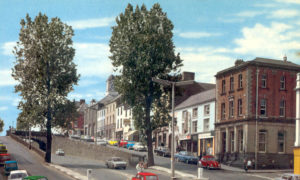
Banbridge, Northern Ireland
The train arrived at Heysham at 11pm. I wasn’t in any hurry to board as there was plenty of time before the ferry left, so I just wandered along with the crowd.
Once on board I went straight to the purser and asked for a cabin as I was told to do when I booked my ticket. He just laughed. He said I’d be lucky to find a seat, let alone a cabin.
He was right! I found a seat eventually but the lounge was full of drunk Irishmen singing and fighting and vomiting! There were people asleep or passed out on the floor, beer bottles rolling around everywhere. So much for “almost empty” on Christmas eve!
Most of the passengers were roaring drunk. Some had taken their shoes off and the pong of smelly feet was overwhelming. With all the smoke in the room as well as the stench of vomit and whiskey, I was close to passing out.
I went into the ladies’ rest room and sat on a toilet seat in a cubicle and slept (dozed) for about half an hour, but woke up with such a backache that I decided even the floor would be better.
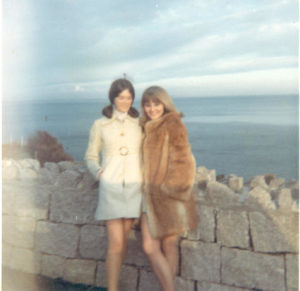
Sandy (right) in rabbit-fur coat with cousin Kay in Northern Ireland, December 1969.
Of course I was wearing my brown suit, gold silk blouse, brown boots and rabbit-fur coat, so I changed into my jeans and sneakers, went out on deck, found a hard wooden bench, used my boots with my skirt on top as a pillow and my coat as a blanket and slept there from 2.30 until 4.30am. There were a few Irishmen staggering around. I suspect they were looking for leprechauns but I no longer cared. I just needed fresh air and sleep!
It was absolutely freezing! The wind coming off the Irish Sea felt like solid ice! At some time during the trip we sailed past The Isle of Man, but please don’t ask me to tell you about it because at the time I must have been going through the painfully slow process of freezing to death!
Clark’s note: Nearly three months later, after spending four wintry months in the UK, Sandy has taken a job as an au pair in Rome, and on her way there stops off at Paris, Marseilles, the French Riviera, and her favorite, tiny Monaco:
MONACO (March 12, 1970)
What a thoroughly divine and absolutely superb and glorious place is Monaco! The most beautiful place I have seen so far in Europe!
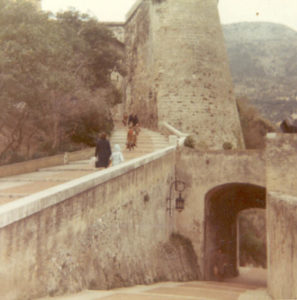
Monaco, 1970
I arrived at 10:30am. The sun is shining and the sky is clear blue. Everyone here is so friendly. As usual, no one here seems to speak English, but for some reason that I can’t explain, it doesn’t matter.
Monaco only takes up about 80 square miles of Europe but it’s a whole country! Well, it’s an independent principality — I’m not sure what the
difference is.
The township of Monte Carlo (in Monaco) is where the gambling casinos are and where they run the Grand Prix, and it’s like a little fairyland.
Monte Carlo is a horseshoe shaped town surrounded by mountains, almost like a mini Acapulco. The harbour is beautiful, a vivid blue sea and expensive-looking yachts all tied up in rows.
I’m told that the changing of the guard at midday at the palace is something that shouldn’t be missed, so I asked in a shop “Prince Rainier’s Palace?” and the man gave me a big smile and pointed up a mountain. I started climbing the seemingly endless steep winding path up the side of a cliff and eventually found myself in the front yard of this sweet little palace.
Yes, in the front yard! I don’t mean behind a high wire fence or peering through gates, I mean I could have walked up to the front door and knocked on it. Well, except for the two guards who looked like cute little toy soldiers and were standing in red and white striped sentry boxes on either side of the door. I doubt they’d have believed me if I’d said Princess Grace had invited me for lunch.
There are glorious gardens cascading down the side of the cliff, along with cannons and little medieval towers. I sat there gazing down at the city of Monte Carlo spread out below and the stunning bay with its many inlets.
There’s also a quaint little Monaco township at the foot of the cliff. It all has a real fairy-tale feel. I had to keep pinching myself to make sure it was real and I wasn’t just dreaming it up.
Changing of the Guard
By 11.30 there were tourists everywhere with cameras ready. Then it happened, and oh it was so cute! If you can imagine it, there’s no division between spectators and guards, it all happens right where you’re standing, not like at Buckingham Palace where you’re out in the street watching through a high fence!
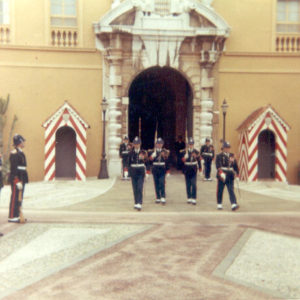
Changing of the Guard, Monaco, 1970
About 10 or 12 guards marched out, two of them banging away on drums hanging from straps over their shoulders. They were out of tune and out of step and that was actually a major part of its charm.
It all took about ten or fifteen minutes, and some of the spectators laughed when it was over or shrugged and waved it away, but I thought it was enchanting and I’m so glad I got to see it.
After that, I had lunch in the palace gardens (a hot dog, but I had to scrape off all the hot mustard!) and had to get this letter started before I forget how beautiful it all is. My express train to Rome doesn’t leave until 6:40 tonight so have plenty of time to just wander around, and what a place to do it in! I wouldn’t have missed being here for the world.
Next Up: On to Rome, Pisa, Spain, Gibraltar, and Various Adventures and Misadventures
Author Bio: Sandy Coghlan is an Australian writer and author of Yesterday: A Baby Boomer’s Rite of Passage, available on paperback or kindle editions at amazon.com. You can also check out her Swinging Sixties Travel Blog here.










4 Responses to An Aussie Boomer’s Rite of Passage, 1969-70